These deliciously sticky, tender Syrian stuffed vine leaves are filled with lemony, garlicky rice and cooked over a bed of chicken legs.
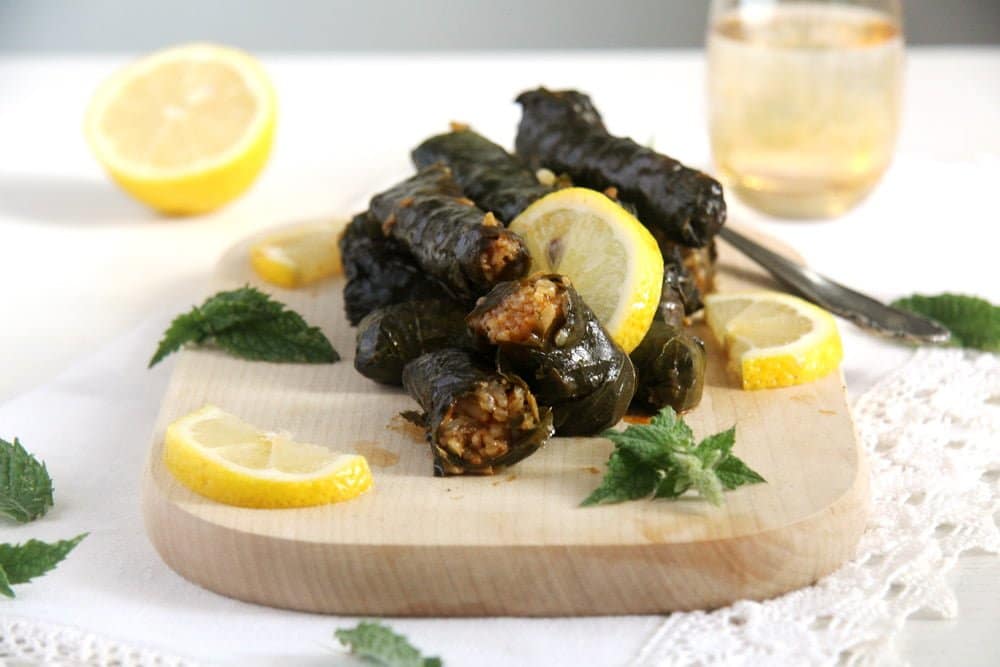
Let me begin by saying that these Syrian stuffed vine leaves are among the best meals I've had in years. I enjoy most of the food I cook or eat elsewhere, but this recipe is truly exceptional!
For me, this is not an overstatement. It is time-consuming and not something you'd make regularly, but once you try it, you'll be amazed. After making it once, the effort won't matter anymore, and you'll make it again and again because it's so delicious. Just thinking about it will make you crave it.
This authentic Syrian recipe for stuffed vine leaves was shared with me by Nesrin, a Syrian friend who has been living in our village with her family for about a year now.
Jump to recipe
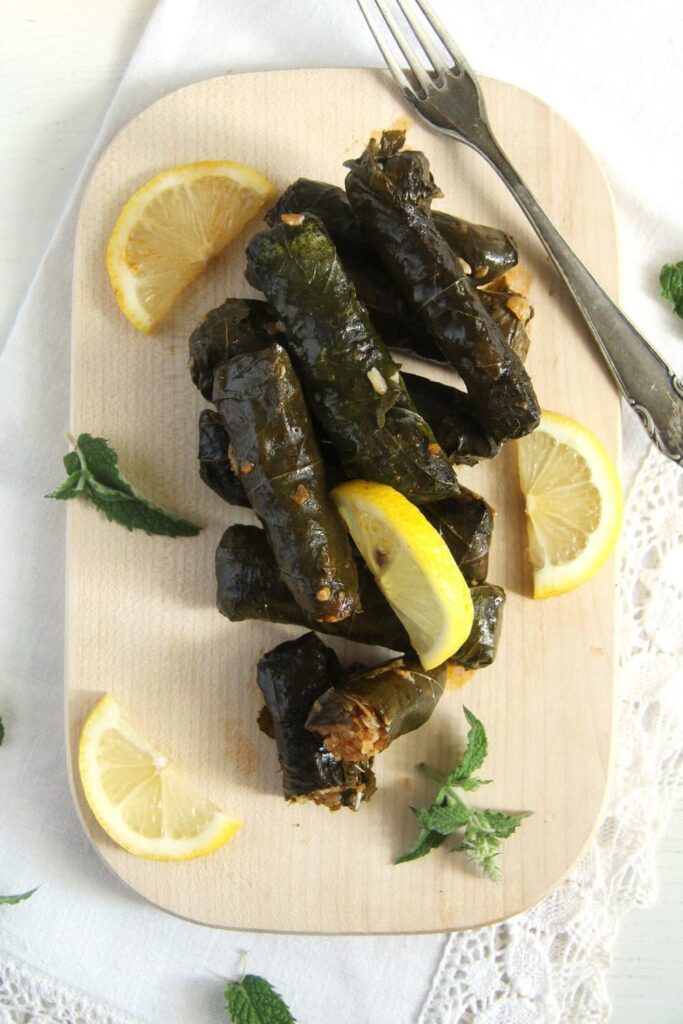
How to make Syrian stuffed leaves?
Rice:
- Place the long-grain rice in a large bowl, pour boiling water over it to cover it, and let soak for 1 hour.
- After soaking it, massage the rice with your hand in the bowl, drain it through a fine mesh sieve, and wash it again under running water very well.
- Let drain well and place it in a large bowl.
Vine or grape leaves:
- I used two large jars of grape/vine leaves in brine (the Amazon affiliate link opens in a new tab), each jar 350 g/ 12.3 oz drained net weight. This amount of vine leaves makes enough food to serve 8 to 10 people or enough servings for a few days.
- You can halve the amount of the ingredients to make fewer stuffed vine rolls, but making a large batch is worth it.
While the rice soaks, prepare the vine leaves:
- Drain the vine leaves from the jars very well. Carefully take the leaves apart and remove the stems. If some of the leaves break, you can put some pieces together when filling them and still be able to get a nice roll. Nesrin says that really good-quality leaves don't break so much.
- Bring a large pot of water to a boil and cook the leaves for about 15 minutes, turning them around in the water 3 or 4 times in between. Drain well.
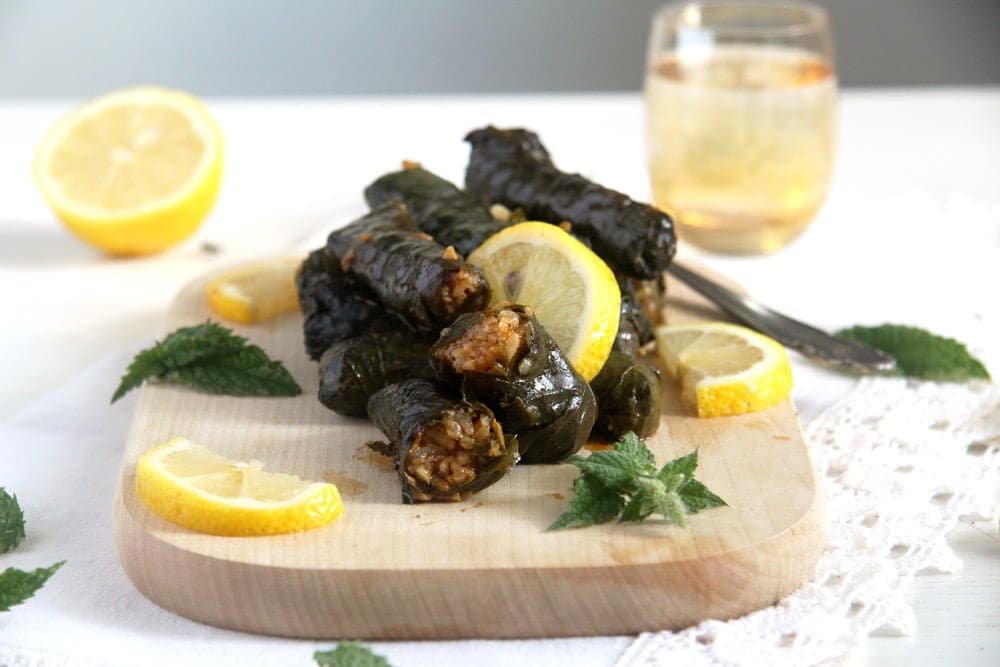
Filling:
- While the leaves are cooking, chop the onion and the herbs very finely. Peel the cloves of 1 ½ of the garlic bulbs and grate them finely.
- Add these ingredients to the drained rice, along with the cayenne pepper, sweet paprika, black pepper, and about 2 teaspoons of salt. I have never seen anyone be so generous with the spices in her cooking. Nesrin throws them in by the handful, but it works. The food is unbelievably tasty without being overladen.
- Mix well, add 2 tablespoons of the pomegranate molasses, about 170 g/ 6 oz of the tomato paste, the olive oil and about half of the lemon juice. Mix very well with your hands.
Pomegranate molasses:
- Pomegranate molasses (the Amazon affiliate link opens in a new tab) is a very much used ingredient in the Middle Eastern cuisine. It is basically a syrup made from pomegranate juice. It is tart and very aromatic.
- You can buy it in Middle Eastern shops and in many larger supermarkets nowadays. It keeps well and is only used in rather small quantities. You will also need it to make this amazing Syrian Muhammara.
Stuff the vine leaves:
- Place one or two grape leaves on your left palm (if you are right-handed). If you have some broken leaves, place more of them on your palm so that you have a nice even layer.
- Place a small amount of the filling about 1 cm above the base of the grape leaves.
- Start rolling, first the lower side over the filling, then the left and right side over the filling, then again from below, forming a relatively tight roll.
- Take a very large pot and place the chicken legs in it.
- Place each vine roll in the pot over the chicken legs, starting circularly around the edge of the pan and continuing with smaller circles towards the middle of the pan. You will have several layers.
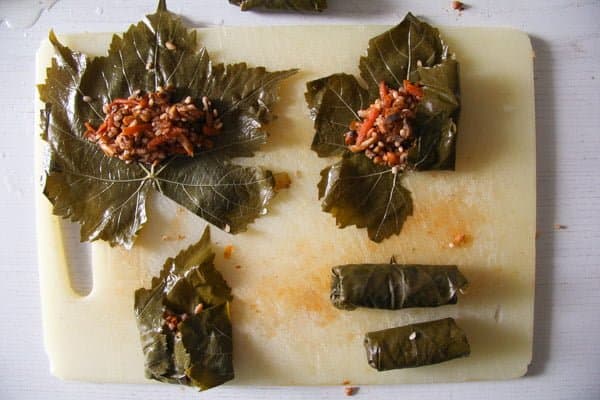
Cook the stuffed vine leaves:
- Place a large plate upside down on top of the rolls. Fill a metal bowl with water and place this on top of the plate. You have to do this so that the rolls will stay put in the pan and not flow around when you add the cooking liquid.
- Pour 2 ½ liter/ 10.5 cups boiling water into a jug. Grate the remaining bulb of garlic and give the garlic to the jug. Add the remaining lemon juice, tomato paste, tablespoon of molasses, and salt (2-3 teaspoons to taste). Mix well and taste; it should taste salty and lemony.
- Carefully give about ¾ of this mixture to the pot with the grape leaves. Pour the HOT liquid slowly into the pot around the edges of the upside plate in the pot.
- Add the remaining bulb of garlic and finely grated cloves to it.
- Add the remaining lemon juice, tomato paste, tablespoon of molasses, and salt (2-3 teaspoons to taste). Mix well and taste; it should taste salty and lemony.
- Carefully give about ¾ of this mixture to the pot with the grape leaves. Turn the heat on high and bring to a boil.
- Reduce heat to medium and cook for 1 hour.
- Reduce the heat to low and cook for another ½ hour.
- Take one roll out of the pan and check to see if the rice is tender. It should be really soft and a bit sticky.
- If it's not done, add some more of the reserved cooking liquid and continue cooking on low, checking from time to time, until the rice is soft, about 20-30 minutes more.
- Use as much of the remaining liquid as needed to keep the rolls stewing in it, but you don't have to use it all.
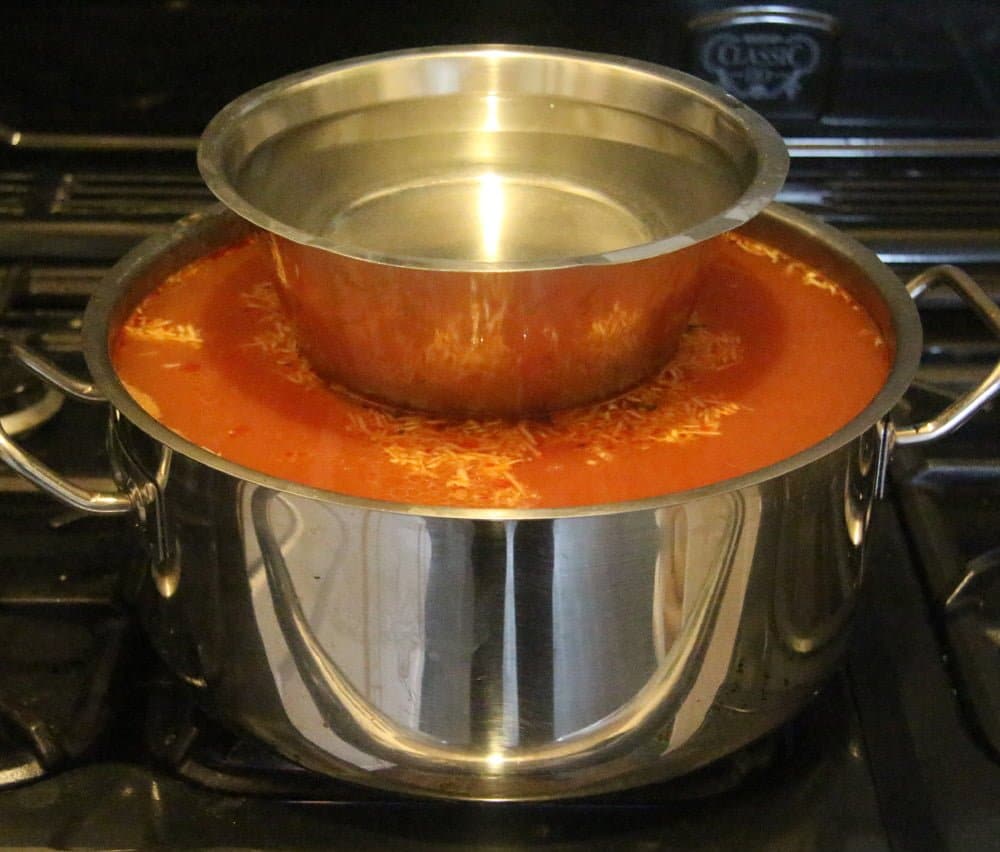
How to serve?
Of course, you can easily halve the recipe for the Syrian stuffed vine leaves, but it's worth making more of them.
They are delicious, hot or cold. You can have them as a main meal or as a snack. You can arrange them on a platter and take them to a party (leave the chicken legs at home if you do that 🙂 ). You can keep them covered in the fridge for up to a week, or so Nesrin says. I don't know; they never last more than three days in our house.
We served the vine leaf rolls with pieces from the incredibly soft chicken legs at the bottom of the pot. They were so good that my mouth was watering just thinking about them!
Serve hot with the chicken legs yogurt or only the stuffed vine leaves at room temperature with yogurt.
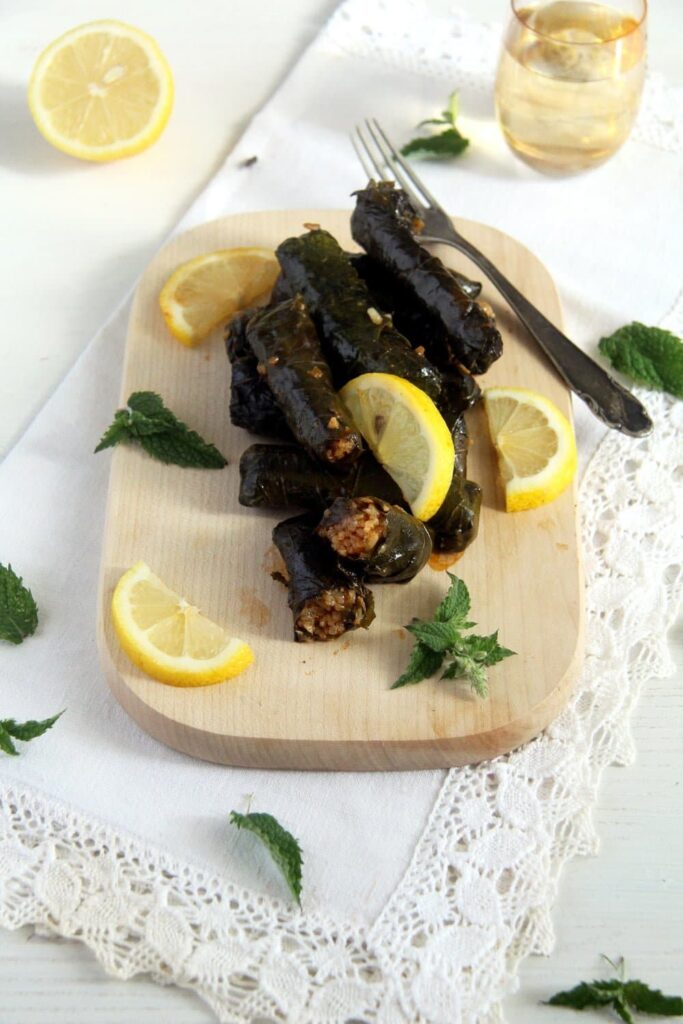
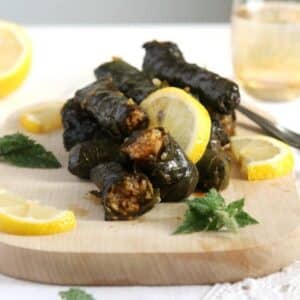
Syrian Stuffed Vine Leaves
Ingredients
- 4 cups long grain rice 1 kg
- 2 jars grape/vine leaves in brine each jar 12.3 oz/ 350 g drained net weight
- 1 large bunch parsley
- 1 handful Syrian mint or regular if you cannot find the original
- 1 large onion
- 2 ½ bulbs garlic that's right – whole bulbs, divided
- 2-3 teaspoons cayenne pepper to taste
- 2 heaped tablespoons sweet paprika
- 1 heaped tablespoon ground black pepper
- 4-5 teaspoons sea salt to taste, divided
- 3 tablespoons pomegranate molasses divided
- 1¼ cup concentrated tomato paste 270 g
- 1 cup olive oil 250 ml
- 1 scant cup lemon juice from a bottle, divided, 200 ml
- 3 large chicken quarters
- Greek or Turkish yogurt to serve
Instructions
Filling for the stuffed vine leaves:
- Soak rice: Place the rice in a large bowl, pour boiling water over to cover it, and let soak for 1 hour. Massage the rice with your hand to clean it, drain it through a fine-mesh sieve, and wash it again under running water very well. Let drain well and place it in a large bowl.
- Prepare the vine leaves: While the rice soaks, drain the two grape leaves jars. Carefully take the leaves apart and remove the stems. If some of the leaves break, you can put some pieces together when filling them and still be able to get a nice roll.
- Cook the vine leaves: Bring a large pot of water to a boil and cook the leaves for about 15 minutes, turning them around in the water 3 or 4 times in between. Drain well.
- Prepare ingredients: While the leaves are cooking chop the onion and the herbs as finely as possible. Peel the cloves of 1 ½ of the garlic bulbs and grate them finely.
- Mix filling ingredients: Add the onions, herbs, and garlic to the drained rice. Add the cayenne pepper, sweet paprika, black pepper, and about 2 teaspoons of the salt. Mix well, add 2 tablespoons of the pomegranate molasses, about 170 g/ 6 oz/ ¾ cup of the tomato paste, the olive oil, and about half of the lemon juice. Mix very well with your hands.
Prepare the vine rolls:
- Take a very large pot and place the chicken quarters in it.
- Stuff vine leaves: Place one or two grape leaves on your left palm (if you are right-handed). If you have some broken leaves, place more of them on your palm, so that you have a nice even layer.
- Add rice: Place a small amount of the filling about 1 cm above the base of the grape leaves.
- Start rolling, first the lower side over the filling, then the left and right side over the filling, then again from below, forming a relatively tight roll.
- Assemble the pot: Place each roll in the pot on top of the chicken legs, starting circularly around the edge of the pan and continuing with smaller circles towards the middle of the pan. You will have several layers.
Cook the vine leaf rolls:
- Place a large plate, upside down, on top of the rolls in the pot. Fill a metal bowl with water and place this on top of the plate. You have to do this so that the rolls will stay put in the pan and not flow around when you add the cooking liquid.
- Mix liquid ingredients: Pour 10.5 cups/ 2 ½ liter of boiling water into a jug. Grate the remaining bulb of garlic and add the garlic to the jug. Add the remaining lemon juice, the remaining tomato paste, the remaining tablespoon of molasses, and the remaining salt (2-3 teaspoons to taste). Mix well and taste; it should taste salty and lemony.
- Carefully add about ¾ of this mixture to the pot with the grape leaves. Pour the HOT liquid slowly into the pot around the edges of the upside plate in the pot.
- Cook Syrian stuffed leaves: Turn the heat on high and bring it to a boil. Reduce heat to medium and cook for 1 hour. Reduce the heat to low and cook for another ½ hour.
- Check doneness: Take one roll out of the pan and check to see if the rice is tender. It should be really soft and a bit sticky. If it's not done, add some more of the reserved cooking liquid and continue cooking on low, checking from time to time, until the rice is soft, about 20-30 minutes more. Use as much of the remaining liquid as needed to keep the rolls stewing in it, but you don't have to use it all.
- Serve hot with the chicken legs and yogurt or at room temperature with yogurt.

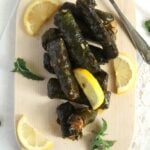
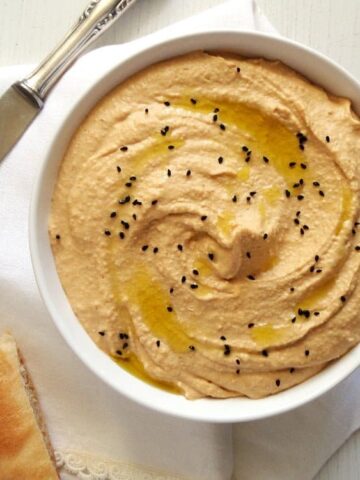
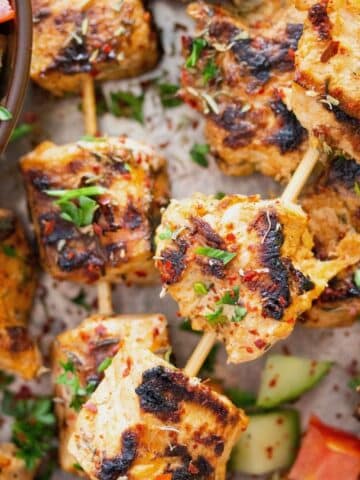
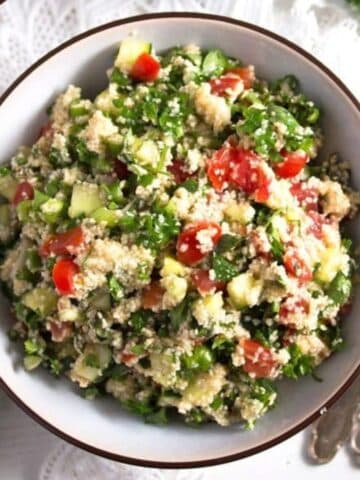
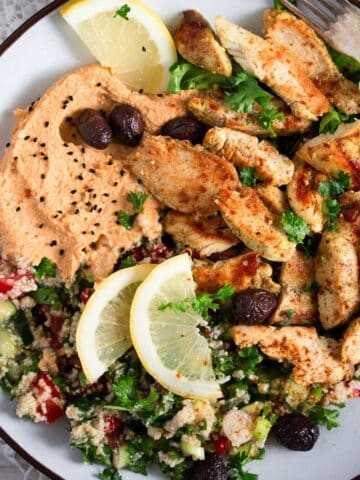
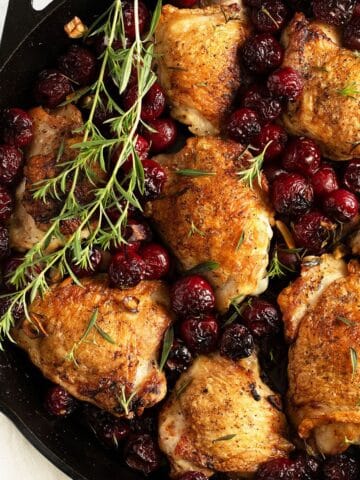
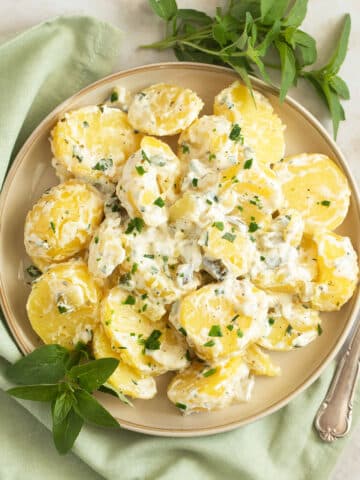
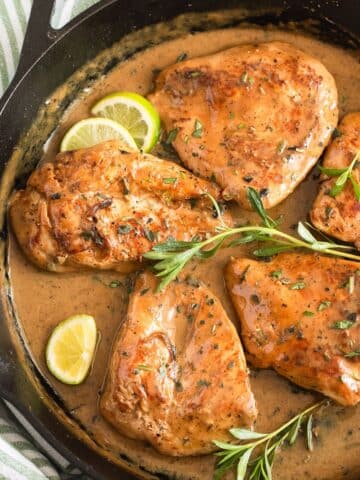
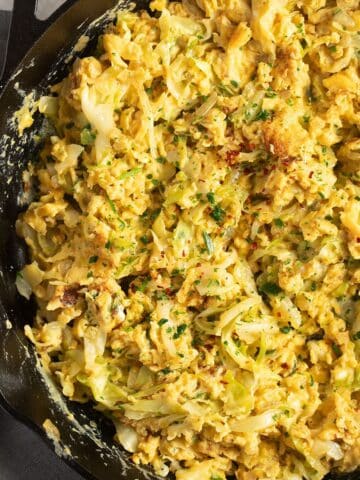

April says
Before the war we used to get grape leaves very similar to these from Newtown market. Thanks for a very flavorful recipe. I modified it a bit (cooked onions and garlic, used Aleppo pepper instead of cayenne, didn’t boil leaves prior to stuffing, cooked in instant pot 23 minutes on high, natural release 10 minutes). Love the robust flavor and super easy recipe. Many thanks.
RAchelle says
Thank you for this! I’ve never tried cooking them on top of chicken thighs. What a delicious idea!
Do you know which city this recipe hails from? I’m interested about regional differences between Syrian dishes. I make a dolmas recipe from Homs.
Adina says
Hi Rachelle. Nesrin, who gave me the recipe, used to live in Aleppo.
Christine Edwards says
Hi there. I work for Preemptive Love Coalition—a nonprofit based in the Middle East. We are a relief and development organization actively involved in helping people affected by the war in Syria.
We want to help people in the U.S. stay engaged with the crisis and thought of using the connecting power of food to do that. Will you help us in this effort?
Tragically, many people in the west only think of Syria in terms of destruction and war. They have no idea about its beautiful culture and ancient history! We hope to challenge that misperception and highlight our shared humanity by creating a series of articles about pre-war Syria that include pictures, recipes, and stories.
While searching for Syrian recipes, we came across your beautiful blog. Would it be ok if we shared your site with our people and linked back to it? We’ll feature some Syrian food bloggers as part of this piece and would love to include you in that.
We also want to talk about what displaced families eat today. One of our programs in Syria is an emergency food kitchen that feeds 31,000 people a day. Most of the time, they serve simple versions of traditional Syrian dishes like mujadara. We would love to build empathy by encouraging people to make a simple Syrian dish like that.
Would you join us in our effort to build bridges, foster empathy, and create a more beautiful world? We thought of several ways we could collaborate but would love to hear your ideas as well. We thought perhaps you could repost or share our story when it runs (hopefully within the next 3-4 weeks)? Or write your own post about these issues? Or share another simple, Syrian recipe that you think everyone should try? We would love to hear your ideas.
Thank you for your time, and please let us know what you think.
Sincerely,
Christine Edwards
Adina says
Hi Christine, it was nice to read your comment. Of course, you can share my post and link to it. I will certainly post another Syrian recipe, I have a few from a Syrian refugee friend living in our village and they are all amazing. If there is more you want to talk about, please write me an email.
Jeffrey Elias says
Tried this recipe to change up my usual stuffed grape leaves for thanksgiving, was dubious of the cayenne pepper so only added a third of what this recipe asked for . Even with the reduced cayenne pepper it was still over powering , would never use this recipe again .
Adina says
I am sorry to hear the cayenne was too much for you, it could be that mine is not as powerful as the one you use. We don't find the dish very hot and we don't usually eat very hot dishes.
Jovina Coughlin says
Lovely recipe
Liz says
My 76 yr old Syrian mother in law tells me that no real Syrian cooks these with chicken, lamb yes but never with chicken. I don't know what kind of Syrian your friend is but her recipe is not authentic, maybe made up by her.
Adina says
Well Liz, I am sure there are as many authentic Syrian recipes for stuffed grape leaves as there are Syrian cooks out there and each one of them probably claims their own recipe is the true one. My friend is born and raised in Syria and only came to Germany two years ago and if she tells me that this is her authentic recipe for stuffed grape leaves, that is definitely good enough for me. Thanks for your comment.
Pamela says
@Liz, My grandmother from Syria taught me to make Yebra. Her recipe was different, as was her sisters. My grandmother used lamb or beef for the filling along with the rice. My father added mint and garlic, my grandmother did not. Her sister used bulgur wheat. We used fresh grape leaves. I still do. My grandmother did use chicken wings in the bottom of the pot. This kept the grape leaves from sticking to the bottom and burning. My father made a grate for the bottom of his pan. Yebra is like stew, everyone has their recipe. There is a difference between the Syrian and Greek versions. The Syrians roll the leaves tight, the Greeks kind of fold them. I hope you are teaching your children to make Yebra. My grandmother taught me, I have taught my grandchildren. This is a meal that they all enjoy helping to make.
Adina says
Thank you, Pamela.
Jeff says
My Great Grandmother brought my grandfather and his 2 brothers to the US when they were 4,2,and almost 1 from Syria, along with her recipes. That whole side of the family still follows her Syrian recipes and her stuff grape leaves were also cooked over chicken wings at the bottom. As a cook myself, I realize there are always different variations on recipes, that's what makes food great. If you order a hamburger from 10 restaurants, each is going to be a little different. That's how you form your "favorites". It amazes me that when people discuss "authentic ethnic food recipes" people not from those regions assume there is only one definitive way it's made. So not true. As my grandmother Mamou would say "open your mouth to eat, before you open it to speak, try it, eat eat I say". Ejoy
Adina says
So true, Jeff. I cannot even begin to tell how often I get this kind of really agressive, hateful comments due to what people think a traditional recipe might look like. Just the other day I was called a fake and other "nice" words for not including peas and parsnips in a Romanian salad recipe my own grandma thought me how to make. It's only food, something to enjoy, nothing that shoudl inspire hate and rejection.
mjskitchen says
These look so different from the Greek grape leaves I'm used to. They look darker and richer and after going through the recipe, the filling sounds fantastic. Thanks for sharing such a unique recipe from my perspective anyway. Love it!
Sissi says
I have no idea about Syrian cuisine, but these stuffed grape leaves look fantastic! (And I'm sure I'd love other dishes cooked by your neighbour as long as she throws spices by handfuls! This is exactly the way of cooking I love most).
Dawn @ Girl Heart Food says
I've never had stuffed grape leaves before, but they look delicious! So nice of your friend to share her recipe with you, especially actually being in the kitchen and showing you by cooking it. Nothing better than that! My grandmother makes stuffed cabbage rolls with ground beef & rice and there's a tomato based sauce which they are cooked in. Such comfort food. I would love to try these too 🙂
Monica says
Sounds amazing. And clearly, you did a great job with the recipe. I've never even had this and I know I've been missing out!!
Anu - My Ginger Garlic Kitchen says
I love grape leaves recipes. My granny used to make grape leaves fritters and these stuffed leaves look and sound wonderful. I know I will love these beauties! 🙂
Nammi says
Being a Muslim it makes me happy to learn that there are refugees who are welcomed into communities. I am born Muslim but we were never taught to be violent quite the opposite in fact and to treat people with respect despite their backgrounds. I think its the media that makes everything bad and of course those lunatics . have never tried these stuffed grape leaves dish, always wondered how they taste. have a nice week
Adina says
Thank you for your comment, Nammi. I know what you mean, it would never cross my mind to blame the entire Muslim world for the bad things some lunatics are doing, if there is one thing I hate in this world than that's intolerance of any kind - the intolerance that leads to fanatism and the intolerance of those blaming Muslims generally for everything...
Chris Scheuer says
Wow, they sound amazing. Lucky you to have a friend like this!
Adina says
I am lucky, Chris! 🙂
grace says
while i have had stuffed grape leaves before, i don't believe they were authentic because they didn't look as good as these or contain nearly the amount of spices! thank you for sharing this recipe!
Adina says
I suppose there are many ways of filling grape leaves, my grandmother had her recipe as well and they were nice, but not nearly as good as these ones. 🙂